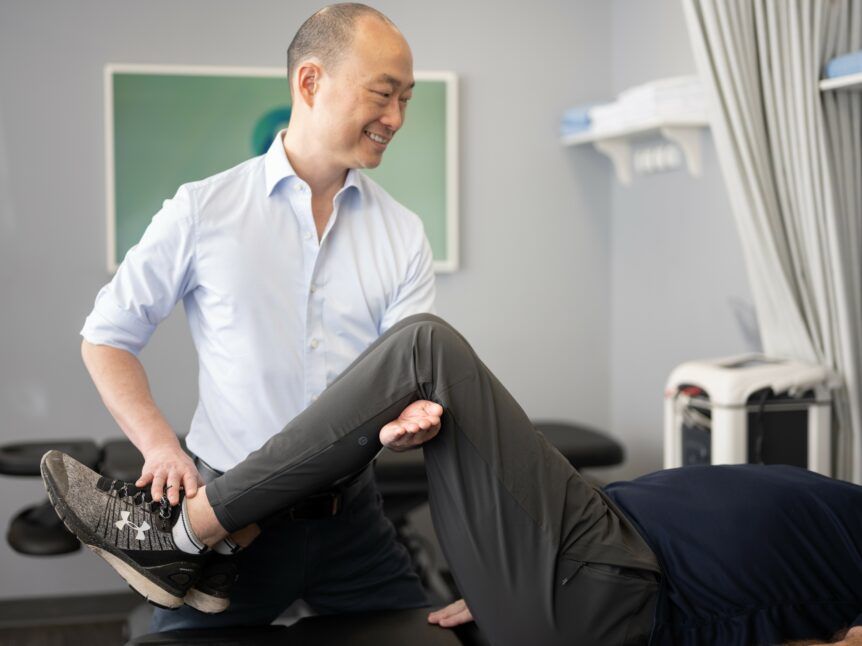
January 16, 2025
Injury recovery is a journey, and the road to healing can be full of obstacles. Many individuals, after experiencing pain or trauma, face the dilemma of how to handle their injury—should they try self-care at home or consult a physiotherapist? While the internet is full of DIY solutions, physiotherapists offer a tailored approach that cannot be replicated through generic advice. This blog will explore what type of common injuries do physiotherapists treat, providing insight into how these professionals accelerate recovery and help patients regain their strength and mobility. Physiotherapy is not just about healing the current injury but also about preparing the body to prevent future occurrences.

January 16, 2025
Sciatica, a condition characterized by pain radiating along the sciatic nerve, can be debilitating and affect daily life in profound ways. The question often arises, can physiotherapy help with sciatica? And the answer is resoundingly positive. Physiotherapy plays a pivotal role in the recovery process, offering both short-term relief and long-term management strategies. In this blog, we’ll explore the multifaceted role that physiotherapy plays in treating sciatica, how it impacts recovery, and why professional guidance is critical to ensure a full recovery.

January 16, 2025
Physiotherapy is often seen as a go-to solution for those experiencing pain, stiffness, or physical discomfort, but the benefits stretch far beyond immediate relief. Whether you’re recovering from an injury, managing a chronic condition, or aiming to enhance your overall mobility, physiotherapy offers a comprehensive approach to improving your health. This blog will take you on a journey to understand how physiotherapy works and how it can do wonders for you. By the end, you’ll have a deeper appreciation for this therapeutic discipline and why it’s essential to seek professional guidance rather than attempt DIY solutions.

January 16, 2025
Injury recovery can be a daunting journey, and for many, it’s not just about getting back to normal but about regaining strength, mobility, and confidence. When faced with the challenge of recovering from an injury, physiotherapy often emerges as a highly effective, science-backed approach to achieving full recovery. How physiotherapy helps with recovery is invaluable, especially when personalized. Whether you’ve experienced a sports injury, surgery, or a simple accident, how physiotherapy helps is through a structured path to healing. This blog will explore how physiotherapy helps with injury recovery step-by-step, providing you with all the key details you need to make an informed decision. Key Takeaways Physiotherapy offers a customized and guided recovery process for a wide variety of injuries. Professional intervention reduces the risk of long-term complications and speeds up recovery. Avoiding DIY solutions is essential to prevent further damage and improve overall recovery. Assessment and Diagnosis The First Step to Healing: Evaluation The first step in the physiotherapy process is a comprehensive evaluation of your injury. A trained physiotherapist will assess your condition, identifying the severity of your injury, its root causes, and the potential impact on your mobility. This step is critical in crafting a personalized recovery plan, as not all injuries are the same. Some may require immediate intervention, while others benefit from more gradual treatment. During this phase, therapists gather relevant medical history and use techniques like range-of-motion tests, muscle strength evaluations, and pain assessments. Based on this data, they can craft a tailored approach to your recovery, ensuring your treatment is precise and effective. Implications This initial assessment is important because it sets the foundation for your entire recovery. Without a thorough evaluation, any self-guided recovery attempt may lead to further injury or incomplete healing. Pain Management The First Step to Healing: Evaluation Once your injury has been evaluated, managing pain becomes a top priority. Physiotherapists employ a variety of non-invasive techniques to reduce discomfort, including manual therapy, heat/cold therapy, and ultrasound. Pain management is not just about comfort—it allows you to engage in more active rehabilitation without aggravating the injury. For example, manual therapy can help release tight muscles, while ultrasound therapy can reduce inflammation in deeper tissues. Pain relief is crucial to moving forward in the recovery process. Insights to Consider While DIY pain relief methods like over-the-counter medications or home remedies might offer temporary relief, they do not address the underlying causes of the pain. Physiotherapy tackles both the pain and its root cause, offering a more comprehensive solution. Rehabilitation Exercises The Core of Recovery: Customized Exercise Plans Rehabilitation exercises are central to the physiotherapy process. How physiotherapy helps is through these exercises, which are specifically designed to improve flexibility, strength, and mobility in the affected area. Depending on the injury, your physiotherapist will introduce exercises that start with basic movements and progressively build towards more complex actions. For example, a patient recovering from knee surgery may begin with range-of-motion exercises, slowly transitioning to weight-bearing movements as their strength improves. These exercises are carefully monitored to prevent overexertion while steadily improving functionality. Broader Context Engaging in these exercises under the supervision of a physiotherapist is critical. Self-guided workouts, especially found online or through well-meaning advice, can cause further strain on your injury. Physiotherapists ensure that your exercises are safe, effective, and appropriate for your stage of recovery. Mobility Restoration Getting Back on Your Feet: Regaining Full Range of Motion Once pain is managed and strength has started to return, restoring mobility becomes the focus. This phase includes a combination of balance training, posture correction, and advanced mobility exercises designed to return you to pre-injury levels of movement. For example, patients with shoulder injuries might work on overhead range-of-motion exercises and stabilizing movements to restore complete arm function. The ultimate goal is to improve flexibility and range of motion, allowing you to return to daily activities without limitations. Perspective to Consider This phase can be tempting for patients to skip or rush, especially as they begin to feel stronger. However, pushing your body too far, too soon can lead to re-injury. DIY attempts to speed up mobility restoration often backfire, making professional guidance essential for a smooth recovery. Prevention of Re-Injury Building Strength and Resilience Once your mobility and strength are restored, physiotherapists will focus on preventing future injuries. This involves creating a maintenance plan, which may include strengthening exercises and lifestyle modifications. The goal is not only to heal but to build resilience in your body so that you’re less likely to get injured again. For instance, patients recovering from a lower back injury may be taught core stabilization exercises to reduce the risk of future back issues. In addition, physiotherapists may address any imbalances or poor movement patterns that contributed to the original injury. Counter Argument: Can’t I Just Strengthen on My Own? Many people believe that they can strengthen their body on their own through regular exercise. However, without the correct guidance, you may unknowingly continue harmful movement patterns. How physiotherapy helps in this context is by providing targeted exercises that not only build strength but also correct weaknesses and prevent further injury. At Motiva Physiotherapy Studio , we’re committed to helping you achieve a healthier, pain-free life through expert physiotherapy care. Want to know how physiotherapy helps with your recovery? Our skilled team, located at 7154 120 Street, Surrey, BC V3W 3M8, Canada, is here to guide you through every step of the healing process. Don’t let pain or mobility challenges stop you—call us at 604-307-8988 today to book a consultation and experience how our personalized care can make a significant difference in your recovery. FAQs Q: How long does it take to recover from an injury with physiotherapy? A: The recovery timeline depends on the severity and type of injury. Some patients may see significant improvement within weeks, while others may require several months of treatment. Your physiotherapist will give you a more specific estimate based on your individual condition. Q: Is physiotherapy painful? A: Physiotherapy should not be painful. While some exercises may cause discomfort as you work through stiffness or weakness, the goal is to rehabilitate without causing additional pain. Q: Can I do physiotherapy exercises at home? A: While your physiotherapist may recommend certain exercises to perform at home, it’s important to have professional guidance. Attempting exercises without proper supervision can lead to improper form or further injury. Conclusion Physiotherapy offers a structured and scientifically-backed path to recovery, helping you regain strength, mobility, and confidence after an injury. From the initial assessment to pain management, rehabilitation exercises, and long-term injury prevention, each step is essential for achieving a full recovery. While it might be tempting to try at-home remedies or exercises, the expertise and personalized care provided by a professional physiotherapist can make all the difference in your healing journey. If you or someone you know is dealing with an injury, ask yourself: why leave your recovery to chance? Get in touch with Motiva Physiotherapy Studio today and discover how physiotherapy helps you regain your strength and mobility.

January 16, 2025
Back pain is a common ailment affecting millions of people worldwide. Whether caused by injury, poor posture, or long hours at a desk, back pain can seriously hinder one’s quality of life. Understanding how physiotherapy works for back pain is essential, as it provides effective treatment options that promote healing and restore function. Through tailored exercises and manual therapy techniques, physiotherapy addresses the root causes of pain, improving mobility and strengthening the back to prevent future issues. While painkillers may offer temporary relief, physiotherapy provides a long-term, sustainable solution to back pain. This blog will explore how physiotherapy works for back pain, why it’s so effective, and why professional treatment is your best option over DIY solutions.

January 16, 2025
Sciatica pain can be debilitating, affecting not only your daily activities but also your overall quality of life. The sharp, shooting pain radiating down the legs can make even simple movements unbearable. While many people seek relief through DIY methods or temporary fixes, physiotherapy offers a long-term solution. But with so many options available, which physiotherapy is best for sciatica? This blog will walk you through the most effective physiotherapy treatments and help you understand why professional care is crucial for sciatica relief.

